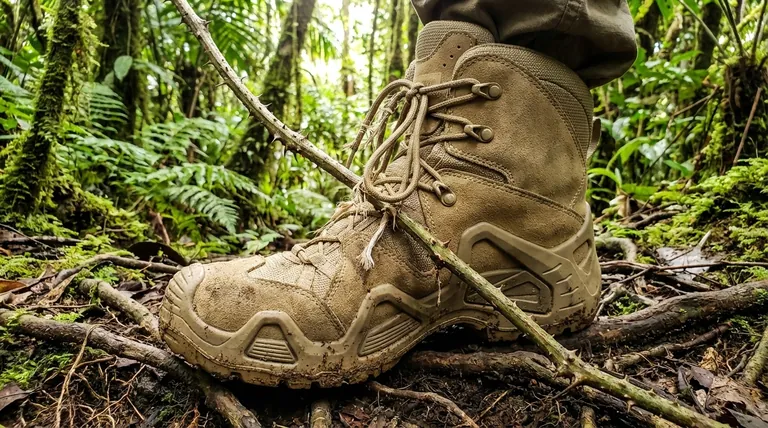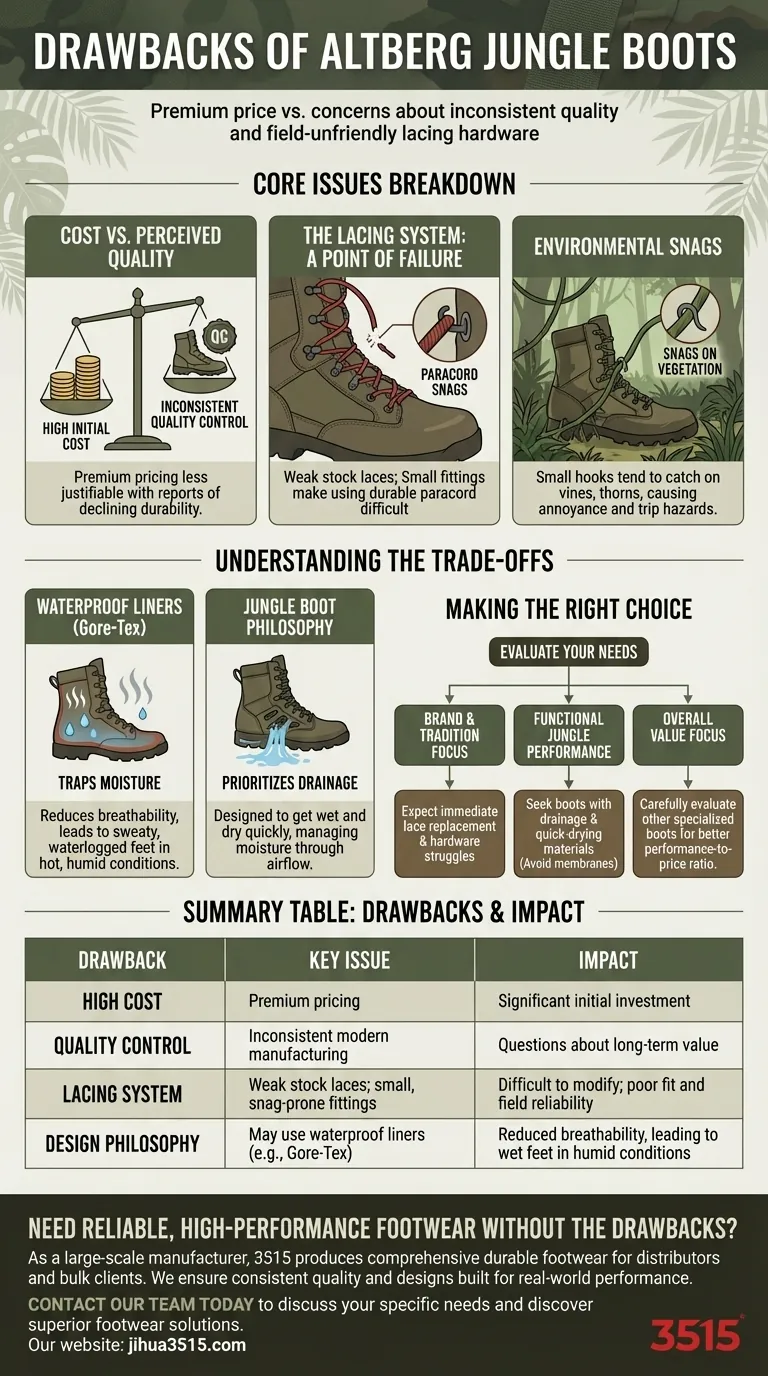The primary drawbacks of Altberg jungle boots are their high cost, reports of declining quality control, and specific design issues with their lacing system. The stock laces are often considered weak, but the small fittings can make using more durable replacements like paracord difficult and prone to snagging.
While Altberg boots have a strong reputation, potential buyers must weigh the premium price against concerns about inconsistent modern quality and lacing hardware that may not be suitable for field modifications.

Breaking Down the Core Issues
The decision to invest in a high-end boot like an Altberg requires a clear understanding of where it might fall short, especially in demanding jungle environments.
Cost vs. Perceived Quality
The most immediate drawback is the high initial cost. Altberg positions itself as a premium brand, and its pricing reflects that.
However, some users have reported a perceived decline in quality control in recent years. This creates a value problem: paying a premium price is less justifiable if the construction and durability are not consistently superior to competitors.
The Lacing System: A Point of Failure
A boot's lacing system is critical for fit and support, and this is a notable area of concern for the Altberg jungle boots.
The stock shoelaces are considered a weak point, with many users finding them prone to breaking under stress.
A common field solution is replacing them with paracord, which is far more durable.
However, the lace fittings (eyelets and hooks) are reportedly too small. This makes it difficult to thread and properly tension paracord, undermining the effectiveness of the lacing system for achieving a secure fit.
Environmental Snags
The design of the lacing hardware itself can be a problem in dense jungle environments.
The small fittings, particularly the hooks, have a tendency to snag on vines, thorns, and other vegetation. This can be a constant annoyance and a potential trip hazard in thick undergrowth.
Understanding the Trade-offs
When evaluating a boot for hot, wet conditions, the choice of materials and construction involves inherent compromises.
The Problem with Waterproof Liners
While not a specific critique of the Altberg jungle boot in the references, it's a critical consideration for any "jungle" or "waterproof" boot. Many modern boots use a Gore-Tex (or similar) waterproof membrane.
These liners are effective at keeping water out, but they significantly reduce breathability. In a hot, humid environment, your feet will sweat profusely.
The membrane traps this moisture inside the boot, leading to sweaty, waterlogged feet—the very condition you're trying to avoid. This can accelerate the onset of blisters and fungal infections.
The Jungle Boot Philosophy
True jungle boots are designed to get wet and dry quickly. They prioritize drainage and airflow over waterproofness.
They often feature drainage vents to let water escape and are made of materials like nylon and treated leather that don't hold water for long. The philosophy is that your feet will get wet, so the boot's job is to manage that moisture and dry out as fast as possible.
Making the Right Choice for Your Needs
Evaluating these drawbacks helps you decide if the Altberg is the right tool for your specific environment and use case.
- If your primary focus is brand reputation and traditional design: The Altberg may still appeal, but be prepared to immediately replace the laces and potentially struggle with the small hardware.
- If your primary focus is functional performance in a true jungle: Look for boots designed with drainage and quick-drying materials, and be wary of any boot with a waterproof membrane.
- If your primary focus is overall value: The high cost combined with quality control concerns suggests you should carefully evaluate other specialized jungle boots that may offer better performance for the price.
Ultimately, a boot's effectiveness depends on how well its design philosophy matches the reality of your environment.
Summary Table:
| Drawback | Key Issue | Impact |
|---|---|---|
| High Cost | Premium pricing | Significant initial investment |
| Quality Control | Inconsistent modern manufacturing | Questions about long-term value |
| Lacing System | Weak stock laces; small, snag-prone fittings | Difficult to modify; poor fit and field reliability |
| Design Philosophy | May use waterproof liners (e.g., Gore-Tex) | Reduced breathability, leading to wet feet in humid conditions |
Need Reliable, High-Performance Footwear Without the Drawbacks?
As a large-scale manufacturer, 3515 produces a comprehensive range of durable footwear for distributors, brand owners, and bulk clients. Our production capabilities encompass all types of boots, including specialized designs for demanding environments that prioritize function and value.
We ensure consistent quality control and designs built for real-world performance. Contact our team today to discuss your specific needs and discover how we can provide superior footwear solutions.
Visual Guide

Related Products
- Wholesale Waterproof Tactical Boots Custom Suede & High-Traction Soles
- Durable Leather Tactical Boots Wholesale & Custom Manufacturing for Brands
- Durable Leather High-Ankle Tactical Boots for Wholesale & Custom Manufacturing
- Wholesale Lightweight Tactical Boots with Dial Closure OEM & Bulk Orders
- High-Traction Suede Tactical Boots Wholesale & Custom Manufacturing
People Also Ask
- What are the advantages and disadvantages of waterproof tactical boots? A Guide to the Key Trade-Offs
- Why is waterproofing important in tactical boots? Essential for Foot Health & Mission Success
- How do military camouflage boots protect against adverse weather? Ensuring Dry, Warm Feet in Any Condition
- Are military camouflage boots waterproof? How to Choose Boots That Keep Feet Dry
- What waterproof technology is used in tactical boots? Unlock All-Weather Performance & Protection



















